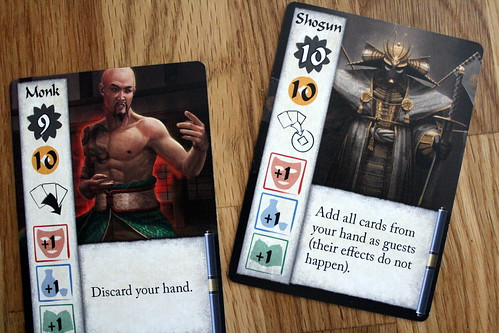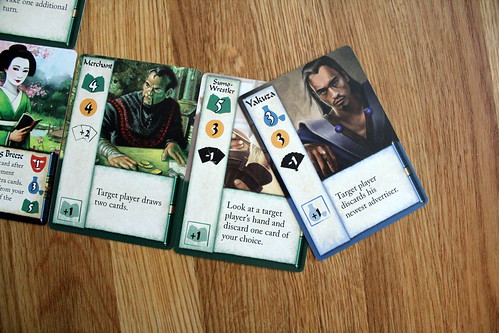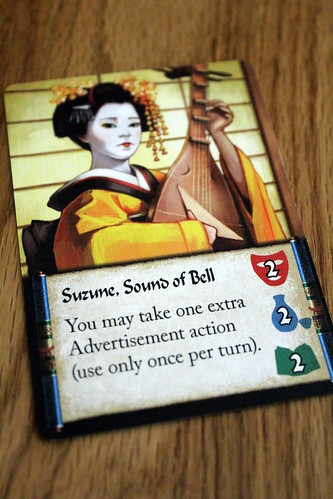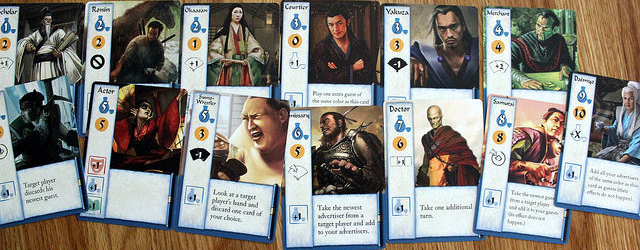| Strategy | Luck |
|---|---|
| Interaction | Components & Design |
| Complexity | Score |
* That’s the manufacturer’s recommendation, but really, most 10 year-olds won’t have issues with this game.
** 2010 for the original Japanese edition
Playing games is, very unfortunately, not a part of geisha’s skill set in Mai-Star, another Seiji Kanai card game Alderac brought to the US as part of their Big in Japan collection. It’s a game about geisha, about the business side of their world. Because clients that want to hear you play the electric shamisen don’t just come running, you have to work on your reputation to attract paying customers. Reputation is everything, and at the beginning of a game of Mai-Star, your reputation isn’t much. Some of the geisha you play have better starting reputations, some have worse and make up for it with stronger special abilities, but none of them are outstanding in the three categories performance, service and intelligence. They can attract customers that are well off, but not the rich and mighty with their higher standards.

That’s why most of the cards you play do not actually become your clients, they become advertisers for you. Why exactly they would advertise for you when they were never your client is a question best left unasked, but advertise for you they do. Each card you play as an advertiser, from lowly Scholar to the mighty Daimyo, increase one of your skills by one or two points. Of course, knowing a Daimyo doesn’t really make you smarter, but making you seem smarter to other prospective customers is all it takes. Cards played as advertisers increase your reputation and make it easier to catch paying clients.
Which is the other use of those cards. If you meet a cards requirement, which is always a high enough value in one skill, never combinations, you play them as a client. Clients are nice to have because they bring you money. It doesn’t have any economic use in this game, but money is victory points, and winning is nice. On top of that, you can convince your clients to do you some favors – use their card abilities when you play the card. Just like they are willing to spend more money, clients that were harder to get also do you more powerful favors. A Scholar, who only requires you to have one point of skill, can make any player draw a card. You’ll see in a moment why that may be a bad thing for the player. The much more demanding Samurai goes out and kidnaps a client for you. He takes a client away from another geisha, puts a sack over his head, carries him over to your place and unloads him with your clients. And the poor guy is scared enough to stay and pay you. That is the main interaction you get in Mai-Star: mess with the other players advertisers and customers. The Samurai is the most powerful card for that, but a Thief can remove a client from another player and a Yakuza can kill their newest advertiser. But you’re not without defense against those attacks. Counting a Ronin among your clients helps against all of those, when anything should happen to you, you can discard his card and prevent the effect. You’ll have to supply the samurai movie scene how he fights off the Yakuza yourself, but he does it.

The most powerful cards, however, are the three Daimyos, the Shogun and the Monk. The Daimyo turns all your advertisers of the same card color into clients – and since cards of the same color are the ones advertising the required skills, that is usually a nice bunch of cards. But that’s still nothing compared to the Shogun, the most powerful man in the country who doesn’t want your geisha to have a specific skill, as long as she has an outstanding ten points in any of the three you can take him as a client. When you do, he lets you put down all your remaining cards as guests, because the Shogun is a generous man and pays for everyone. The Monk is less generous, but still powerful, he lets you discard your hand. Why is that effect so powerful? Because as soon as a one player empties their hand of cards, the round ends, points are counted and the next round starts from nothing again. Playing either of those cards immediately ends the round, right after adding another ten points to your score.
To end a round when it’s convenient for you is the deciding factor to win in Mai-Star. It doesn’t matter that you have more points than everyone else if you still have cards in your hand that you can’t easily get rid of. That’s why playing Scholars against others is so much fun, you force them to draw cards when all they want is to end the round. And there is only one way – besides the Monk and the Shogun, who rarely show up when you really need them – to reduce your hand size: play clients. Playing advertisers doesn’t help, when you do you draw a new card, and you can’t take an action to simply discard a card, either. Drawing more cards is easy, you can always use your turn to draw one, but getting rid of a card is tough. And so is saving your score while you struggle to get rid of cards and the other players are killing your clients.

How exactly you deal with that depends strongly on your chosen geisha for this game. Their special abilities are not just powerful extras, they are a blueprint to your strategy. Use that ability well and you win, ignore it and you don’t. For instance Momiji, Maple Leaf, can use the card effect from all red clients she plays twice. If you don’t go searching for red cards to make use of that, it’s your own fault. Use your turns to exchange two cards from your hands against two fresh ones, an action anyone can take, until you find the red Samurai and Thieves, then quickly decimate your opponents’ customer base and end the round. A similar strategy works for Natsumi, Summer Sea, who may play another blue customer after playing a blue customer. It’s the one shortcoming I see in Mai-Star that those abilities are not perfectly balanced. There is one geisha, Suzune, Sound of Bell, that just stands out. She has weak starting scores, but she may take an extra advertising action every turn, meaning that a) those scores go up quickly and b) she can protect her valuable advertisers from the Yakuza by advertising twice in one round and placing a less valuable one afterwards. If she gets a Daimyo early in the round she can beef up her advertising in that color and play him to turn all those people into clients, scoring enough points that doing it once in a three-round game is often enough to win. She’s not unbeatable, but she sure has an easier time than a geisha with great starting scores but two extra cards as her only super power.
Mai-Star is what we have come to expect from Seiji Kanai, a game that is quickly explained, quickly played and a lot of fun. It’s a deeper and more complex and game than Kanai’s flagship Love Letter, but come on, as much as I love Love Letter, it doesn’t take much to be more complex. Mai-Star is still easy to play after your third sake, and you can probably still learn it after your second. Doesn’t mean you have to be drunk to enjoy it, all you need for that is the ability to laugh at your opponents while you do bad things to your client, because interaction in Mai-Star is always negative, and to really enjoy the game you have to be ready to use your abilities to take other players cards away. That’s the point of Mai-Star, a light game with a lot of “take that” action. That’s what it does, that’s what it does well. It does it better with three or four players than it does with five or six, rounds just get too long, but it still does it well. You won’t have to hire geisha to play with you, it should be possible to convince your friends.
(With thanks to Alderac Entertainment for the review copy!)










